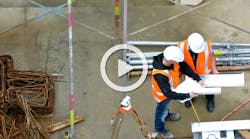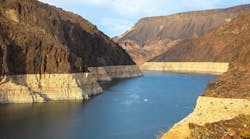Project Profile: Mountain Paradise Maintained
The residents of Yellowstone Mountain Club near Big Sky, MT, enjoy exclusive use of acres of ski runs, a designer golf course, and fishing in clear mountain streams. The fish in these streams also enjoy improved living conditions because of the Yellowstone Club’s willingness to work in conjunction with regulatory agencies to derive engineering solutions that are sensitive to the surrounding mountain environment.
Segments of the Yellowstone Club’s 40 miles of roads cross important streams and fish habitats. Concurrent with upgrading these stream crossings, significant improvements have been made to the streambeds and stream hydraulics.
At two key stream crossings, the EPA and Montana Fish, Wildlife & Parks had specific requirements for the development’s road upgrades. First, flow velocities for a two-year recurrence flood needed to be significantly reduced. Second, the crossings needed adequate passage for small mammals during low-flow conditions.
The selected alternative for both crossings–a bottomless arch pipe with poured concrete footers–has achieved all goals. The bottomless arch design allows the natural streambed materials and hydraulic characteristics to be maintained. Stream velocities for the design flood have been reduced from over 20 feet per second to the required range of 5 to 7 feet per second. Adult fish are now able to travel upstream at most flow conditions. Montana Fish, Wildlife & Parks representatives have called the design a model for future culvert replacement projects.
Mountain Roads and Streams
The Yellowstone Club’s roads, originally constructed and used by the logging industry, cut across steep mountain terrain. A comprehensive inventory and evaluation of road drainage structures throughout the property allowed engineers and hydrologists to prioritize replacement or upgrade projects based on water-quality and fisheries concerns, among other factors.
Among the structures slated for replacement were two large culverts on sensitive perennial streams flowing through the property: Second Yellow Mule Creek and a tributary to the Gallatin River known as the South Fork of the West Fork (South Fork). Westslope cutthroat trout, a species of concern in Montana, populate both streams.
The existing culvert crossings were proposed for reconstruction. The crossing at Second Yellow Mule Creek required replacement of an approximately 100-foot length of existing 60-inch-diameter corrugated metal pipe. The crossing at the South Fork required replacement of a 72-inch-diameter squashed corrugated metal pipe located upstream of the main Yellowstone Club bridge.
PBS&J, an engineering and natural resource consulting firm, provided hydraulic engineering and environmental permitting for the projects. PBS&J staff teamed with engineers Mike DuCuennois, Bill Hartsog, and Glenn Wood. Hydrologists and fish biologists evaluated culvert replacement alternatives using the HEC-RAS hydraulic model and the Federal Highway Administration model HY-8.
Sensitive Design
At Second Yellow Mule Creek, an evaluation of flow velocities and the physical configuration of the site were used in selecting a 12-foot bottomless arch culvert to replace the existing 60-inch-diameter culvert. Hydrology calculations using regional regression equations estimated bankfull flow to be 53 cubic feet per second (cfs).
At this flow, the velocity through the existing culvert was estimated to be 12.5 feet per second (fps). However, calculations indicated that flow would be reduced to 6.2 fps with the proposed new culvert. The bottomless arch was designed with footers buried 2 feet below channel grade to avoid the effects of scouring, a sufficient depth considering that the average scour depth was calculated to be 0.8 feet.
Bankfull discharge at the South Fork Crossing was estimated to be 80 cfs with predicted scour depth of 2.2 feet.
Several large boulders were strategically placed at the outlet of each culvert, effectively creating a weir. The boulders create a hydraulic condition that promotes accumulation of small, spawning-size gravel at the bottom of the culvert. The hydraulics around the boulders also mimic conditions found in other natural areas of the streams and do not pose a barrier to upstream migrating fish trying to enter the culvert. The boulders also create a slight backwater effect through the culvert, increasing water depth and enabling upstream passage by younger age–class fish.
In addition to providing hydraulics more conducive to fish passage, the new culverts were also successful in providing conditions needed for amphibians and small mammals. During low-flow conditions, the channel margins and larger substrate are sufficiently dry to provide unimpeded passage for these animals.
Careful Construction
Due to the similarity of the sites, culvert replacement work at both streams was conducted with the same goals and precautions. Most importantly, careful attention at all stages minimized water-quality impacts. Construction activities were completed under the direction of a hydrologist or engineer familiar with sediment mitigation measures. Engineers elected to work in-stream and maximize the use of mitigation techniques rather than build a diversion channel (see sidebar).
Regardless of mitigation steps taken, a few specific activities were anticipated to result in some downstream movement of fine sediment. These specific activities included removal of the existing culvert, the return of all flow into the newly exposed channel bed, and the installation of rock weirs at the culvert inlet and outlet.
Effects were minimized by planning construction for late fall and winter when flows are at their seasonal lows. In addition, dewatering channels were constructed in the center of the stream channel after the existing culverts were removed to minimize water seepage into the excavation area and to reduce any effect on water quality during excavation of footer trenches and installation of concrete footers.
To meet state stormwater discharge requirements, silt fences were installed at the toe of the road fill to minimize sloughing or sidecasting of soil and rock into the channel during excavation. The rock weirs constructed with large boulders at both the inlet and outlet of each culvert helped ensure channel stability around the footers after project completion.
Monitoring for Success
Construction of the replacement culverts was completed in December 2004. Both sites have seen a marked improvement in fish habitat. With stream velocities adequately lowered and safe passage improved for native fish, amphibians, and mammals, streambed stability is the remaining challenge. Annual monitoring for five years will determine whether all design criteria are being met.
After each year’s spring runoff, photographs are taken at selected monuments. The photo set will include at least one photo of the streambed taken at each of three locations, including a maximum of 50 feet upstream of the culvert, 50 feet downstream of the culvert, and through the culvert. The annual monitoring report will also include a qualitative description of the vertical stability of the channel upstream and downstream of the culvert as well as between the weirs (through the culvert).
Since fall 2004, the channels both upstream and downstream of Second Yellow Mule Creek and the South Fork have remained stable–as have the portions of the channel within the weirs. At the South Fork site, some rearrangement of the smaller streambed material has occurred, but there has been no observable downcutting. Scour along the concrete footers has not been observed at either stream. Material inside the culverts is of a similar size distribution to the natural channel bed both upstream and downstream of the road crossings.
The project has proven to be a success on all levels and to all parties involved, from the developers to regulatory agencies. Residential and recreational developments in similar settings can look to the improvements at the Yellowstone Club and know that creative solutions exist for their sensitive drainage upgrades.


